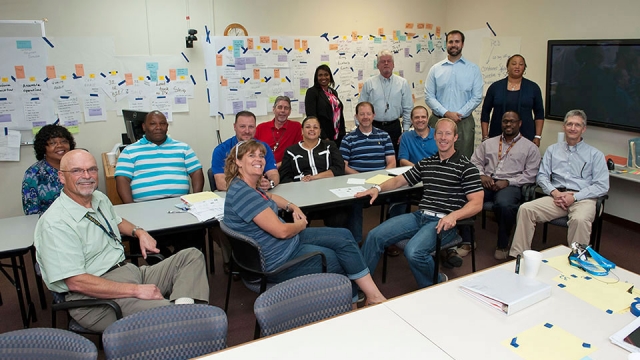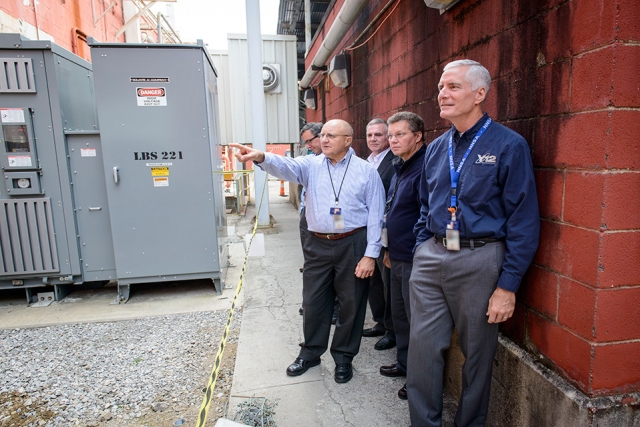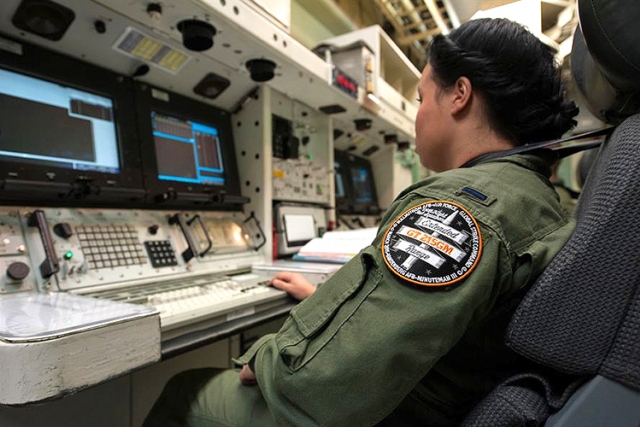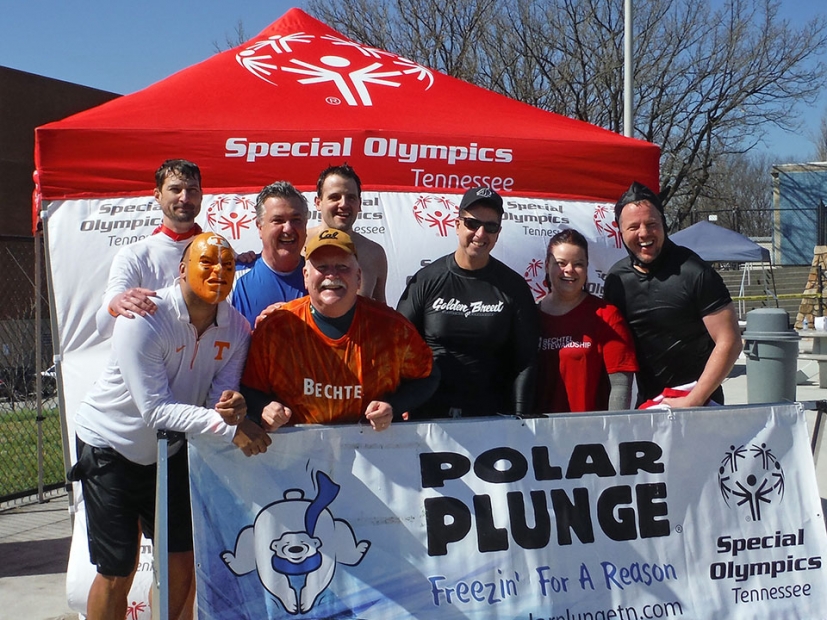Y-12 Blog
 An integrated team of Pantex and Y-12 employees (some members shown here) work on the beginning stages of the container improvement initiative.
An integrated team of Pantex and Y-12 employees (some members shown here) work on the beginning stages of the container improvement initiative.
For Pantex and Y-12, delivering the mission as one team is more than the sum of its parts; it’s a shared responsibility to find smarter ways to integrate resources, eliminate redundancies, tackle shared problems and break up bottlenecks. That, in turn, helps to better meet mission requirements at both sites.
With more than a thousand miles separating the sites and decades of operating independently, becoming one team hasn’t been easy, but it makes sense. The production sites play an essential role in the nation’s defense and nonproliferation strategy. The two sites’ missions are intertwined and now so are many of their operations.
Several Consolidated Nuclear Security, LLC (CNS) organizations are playing an important role in integrating the sites’ processes and systems. “Our CNS team is accomplishing integration on a scale that has never been done before within the Nuclear Security Enterprise,” said Darrell Graddy, CNS’s vice president for Operations Support. “We’ve already made a lot of progress, but there is still more that can be done.”
Graddy said the biggest challenge is to “raise the standards in everything we do to a level reflective of our mission success.”
Following are a few examples of how CNS employees are fostering a collaborative work environment.
Mission first
CNS synchronized weapons baseline schedules for Pantex and Y-12. Both sites jointly reworked the B61-12 Life Extension Program project schedules to include bottom up resource estimates and integration of key subprojects. The team also consolidated the Earned Value Management System — the method used to plan and measure the cost and progress of large projects — on both unclassified and classified platforms.
“The result of these efforts was the successful B61 integrated baseline review at both sites,” said James Fine, senior director of Enterprise Planning and Controls.
Integrated mission planning
Another example of cross site collaboration is CNS’s work with the National Nuclear Security Administration, Sandia National Laboratories (SNL) and the National Security Campus in Kansas City on the Logistics, Accountability, Planning and Scheduling project, or LAPS. LAPS encompasses the functions that support many aspects of the Nuclear Security Enterprise weapons production business. The integrated project team is working to deliver new processes and a computer system of integrated technology and data to replace aging applications.
The new system, a first for the Nuclear Security Enterprise, will improve planning capabilities, reduce costs and provide for operational efficiencies throughout the supply chain. “CNS is responsible for leading development of planning and scheduling aspects, and SNL is responsible for accountability and logistics. Together in 2015, we completed a joint proof of concept effort in two closely coordinated project plans,” said John Hudson, senior program manager in Enterprise Planning and Controls. “This laid the groundwork for system requirements definition to proceed in 2016.”
Prioritizing infrastructure upgrades
The National Nuclear Security Administration (NNSA) recently designated Lawrence Livermore National Laboratory, Pantex and Y-12 as BUILDER Centers of Excellence.
BUILDER, a knowledge-based condition assessment software developed by the U.S. Army Corps of Engineers, is being implemented across the NNSA complex to help plan for maintenance and prioritize infrastructure upgrades. The three site team has been working to gather data on every facility in the Nuclear Security Enterprise. All the data — including building square footage; number of windows and doors; and type and condition of foundation, roofing and flooring — have been entered into BUILDER.
“BUILDER will provide an enterprise level understanding of the condition of existing facilities and will allow for a risk-based approach to future infrastructure needs,” said Jane Nations, Y-12 site master planner. “CNS was selected as a Center of Excellence because of our willingness to investigate and share methods to make the NNSA implementation process more efficient.”
Y-12 is developing an Extended Life Program, or ELP, for Buildings 9215 and 9204-2E, two key processing facilities at the site. These two facilities will house all material processing activities not incorporated into the Uranium Processing Facility design.
To better understand what it takes to keep an older, large facility going, a team at Y-12 has conducted two workshops. The invitees included other DOE/NNSA sites and outside experts to share knowledge and experience dealing with aging infrastructure.
The first workshop, conducted in February 2015, provided a forum for exchanges on management challenges, initiatives and processes used to resolve enterprise-wide aging infrastructure issues. Y-12 identified several best practices during the workshop and integrated these concepts into the development of the ELP.
Internal expert-based teams gathered information on material condition, codes, standards, nuclear requirements and operational/maintenance cycles, that was reviewed by workshop attendees so they could provide recommended actions to establish a life-extension program.
The Y-12 team took that data and compiled it for a forum to evaluate and integrate into a recommended Extended Life Program plan. The forum was conducted in November with representatives of NNSA, the Defense Nuclear Facilities Safety Board, and several outside aging management program experts from the Institute of Nuclear Power Operations, Savannah River, the United Kingdom’s Atomic Weapons Establishment and the American Nuclear Society attending.
Workshop presentations noted that the Y-12 infrastructure supporting 9215 and 9204-2E is generally beyond design life, with a significant portion of electrical equipment obsolete and process equipment, in many cases, beyond design life and in need of upgrade/refurbishment.
To address these aging concerns, Y-12 presented a three-prong approach to aging management:
- reduce the material at risk in these facilities so the consequences of any accidents is significantly reduced;
- replace or refurbish key facility infrastructure and process equipment and
- address and update regulatory requirements for extending life (versus a soon-to-be-abandoned/replaced mode).
Workshop attendees’ consensus was that the current program provided a comprehensive appraisal of infrastructure and process material condition and basis for risk identification, risk mitigation and risk acceptance.
In addition, several good practices were identified, including incorporating system outages for replacements, refurbishments and preventative maintenance. There was general consensus that an outage program made up of routine short equipment/system outages and longer periodic outages was required to support the program.
The workshop attendees concluded that current elements of the proposed Y-12 ELP, with improvements to the aging management program and outage program, addressed the essential elements of a workable management program. However, sustained investment will be needed to restore key facility processes and supporting infrastructure, along with an increase in maintenance resources.
With a solid program plan established, the next steps for Y-12 involve determining budget layouts.
 NPO Program Manager David Wall points out infrastructure upgrades to NNSA Uranium Program Manager Tim Driscoll, front, during a recent tour of Y‑12’s Building 9995.
NPO Program Manager David Wall points out infrastructure upgrades to NNSA Uranium Program Manager Tim Driscoll, front, during a recent tour of Y‑12’s Building 9995.
Y-12’s Analytical Chemistry Operations provides comprehensive analytical services in support of the site’s core missions, environmental compliance and overall worker health and safety. ACO scientists, for example, analyze impurity levels to ensure the materials destined for nuclear weapons or naval reactor fuel are of suitably high quality. They also analyze soil and groundwater samples for hazardous contaminants and characterize the site’s waste output to ensure regulatory compliance.
Much of this crucial work, however, is done in a degrading laboratory using equipment well beyond its intended life cycle. A 2014 baseline assessment of the facility outlined the most significant issues and identified numerous single-point failures and associated risks. To address the risks, of course, ACO would need money.
In late August of that year, NNSA Uranium Program Manager Tim Driscoll toured Y-12’s primary lab facility, Building 9995, and saw firsthand the need for infrastructure investments. Four days later, he committed $5 million toward improvements, but with one caveat: CNS must match the funds.
“Our senior managers made a commitment to DOE that we could do this,” David Maguire, Maintenance Program manager, said. “We were able to come up with the money by deferring some planned scope into later fiscal years and utilizing underruns from other areas within maintenance programs.”
Driscoll’s contingent offer, unique among project funding, proved successful. “This allowed us to obtain $5 million of additional funding to address serious infrastructure needs in one of our mission critical facilities,” Maguire said.
The funding was secured relatively quickly, and, over the course of the year, that $10 million was used for a number of equipment and facility upgrades. One major beneficiary was 9995’s radiochemistry laboratory, which separates isotopes from uranium using concentrated levels of
specific acids. The use of those acids necessitates ventilation hoods capable of meeting certain safety requirements. Until recently, only five of the lab’s nine hoods met those requirements, leaving the other four out of commission.
“Since each hood is ten feet long, the lab effectively lost forty feet of work area,” said Darrin Mann, manager of the radiochemistry labs. “This forced the lab to double and triple up in the remaining hoods to meet the site’s analytical needs, resulting in very crowded work areas.”
A portion of the $10 million funding source went toward replacing all nine hoods with lighter, shatter-proof windows, giving each technician their own hood to safely and efficiently handle hazardous chemicals.
“The hood flow has been greatly increased as well, reducing any potential fume exposure in the lab,” Mann noted. “And there were other modern updates such as better placement of electrical connections and an integrated lighting system to improve working visibility.”
In addition to the hood replacement and improvements, the funding helped upgrade electrical panels, install a new transformer, and improve the HVAC system in Building 9995. ACO Manager Jim Placke noticed immediate benefits.
“We now have much better control of temperatures in the labs, which is critical for some of our sensitive analytical equipment,” Placke said. “Overall, we have a better work environment, and we’ve reduced future risks to operations.”
Once funding was received, all the planning, procurement and installation activities for the various improvements were planned and executed expeditiously.
 A Missile Combat Crew commander from Malmstrom Air Force Base, Mont., practices procedures at Vandenberg AFB, Calif., in preparation for the launch of an unarmed Minuteman III intercontinental ballistic missile. Photo: U.S. Air Force photo, Michael Peterson
A Missile Combat Crew commander from Malmstrom Air Force Base, Mont., practices procedures at Vandenberg AFB, Calif., in preparation for the launch of an unarmed Minuteman III intercontinental ballistic missile. Photo: U.S. Air Force photo, Michael Peterson
Standing 30 feet below the cold, snow-covered Montana earth, looking at a live, 60-foot-tall Minuteman III missile that he could reach out and touch (if that were allowed), Alan Armentrout found himself speechless.
“I’ve tried, but I can’t even come up with a word to describe it,” Armentrout, a machinist in Special Materials Operations, said. “You could say ‘powerful’ or ‘amazing’ or something, but none of those are strong enough.”
Armentrout and five other Y-12 Production employees — Dwayne Beaty, Aaron Burlingame, Marty Fritts, Jim Hackworth and Carl Hill — spent a week last month at Malmstrom Air Force Base near Great Falls, Montana, witnessing firsthand the active missiles whose nuclear payloads begin as materials and shapes in Y-12’s production facilities.
The group climbed down into a Minuteman III missile silo; toured the associated launch capsule where, behind 10-ton blast doors, Air Force operators sit strapped into chairs at their workstations; and witnessed a warhead changeout from both the silo and the payload transporter situated above the silo’s opening.
“You’re standing in that silo, looking up at the tip of that missile near the surface and just thinking about what it can do,” said Burlingame, a 9212 supervisor. “It was an eye opener.”
Throughout their time in — and under — Montana, the men couldn’t help but think of Y-12, nearly 2,000 miles away, and its role in the massive display of force in front of them.
“At Y-12, we get entangled in schedules and the minutiae of running a shop daily,” noted Hackworth, Special Materials Operations production manager. “But all the work we do has converged to this one point. These nuclear weapons are there, and they need to be able to go off at any point. All the work we’re doing really counts.”
On the first day back at Y-12, Fritts, a supervisor at the Highly Enriched Uranium Materials Facility, took that message to his crew. “I told them that they do have a bigger purpose,” he said. “We might think that moving a can here or there seems tedious, but it’s the beginning of this whole process. I’ve seen that end product now, and it wouldn’t get done without us.”
Armentrout has already noticed that perspective affecting the way he approaches his work. “I think I pay attention more to all the little details that protect what we’re doing,” he said. “I appreciate even more what we do and feel an immense amount of pride.”
As a bonus, the group was able to sit in on an intelligence briefing. For most, it was their first time hearing a detailed assessment of foreign relations and threats. “The world is a dangerous place,” Burlingame said. “There’s a real threat out there and a real need for these weapons.”
That need, Fritts thinks, is ultimately about peace. “These things are there to guarantee peace,” Fritts said. “We certainly hope they’re never used, and so does everyone else — that’s why they are so absolutely essential to our defense.”
For Burlingame, the trip is still largely indescribable. “It was something visceral,” he said of his experience. “We play a major role in national security. That’s clear to me now, and those words have taken on a whole different meaning.”
 UPF employees collected donations to determine who would take the Polar Plunge, a leap into the University of Tennessee’s outdoor swimming pool.
UPF employees collected donations to determine who would take the Polar Plunge, a leap into the University of Tennessee’s outdoor swimming pool.
Managers from the Uranium Processing Facility raised nearly $9,000 for Special Olympics Tennessee by leaping into ice cold water on Feb. 27 as part of the Polar Plunge, an annual fundraising effort.
UPF was the top fundraising team in Knoxville, contributing 45 percent of the total amount raised in the city, and four UPF managers — Aaron Love, Tony Giordano, Matt Nuckols and Jim Sowers — were the top individual fundraisers. Other UPF participants were Bob Bentley, Mark Braccia, Joe Brown, Jesse Jones, Mike Pratt and Bryan Roberts.
Nominees collect donations to determine who will take the Polar Plunge, a leap into the University of Tennessee’s outdoor swimming pool. At UPF, it was a hotly contested race until the polls closed on Feb. 25. Ultimately, Deputy Engineering Manager Aaron Love edged out Deputy Project Manager Tony Giordano for the top spot by a mere two votes, raising $1,857.
“Thanks to good-natured competition and the generosity of UPF personnel, we led the city in fundraising for this great cause,” said NextGen president Amit Patel.
NextGen is an employee resource group focused on supporting the orientation, development, retention and empowerment of employees as they begin and build their careers.
